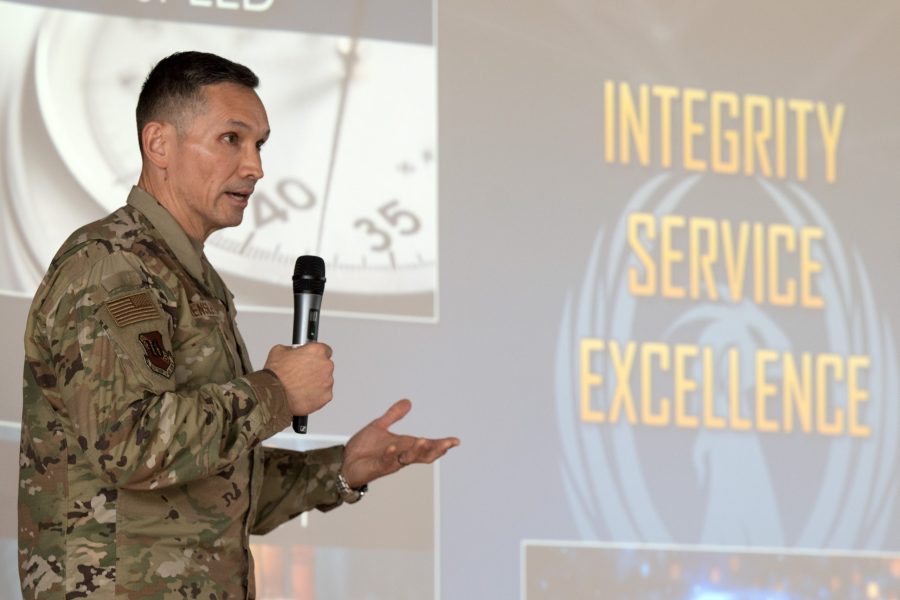Six months after Air Force leaders announced sweeping moves to re-optimize for great power competition, one of the main units affected by the changes still faces an uncertain future.
The 16th Air Force, a sprawling Numbered Air Force that encompasses cyber attacks, electronic warfare, traditional surveillance and reconnaissance, public affairs and information operations, and weather forecasting, is due for a major shakeup, new commander Lt. Gen Thomas K. Hensley acknowledged in a conference call with reporters: Air Forces Cyber is being elevated to the status of a service component command, on a level with Pacific Air Forces or Air Forces Central.
That leaves a question mark over the future of the 16th Air Force, since AFCYBER is a significant proportion of the 49,000 strong unit.
Air Force Secretary Frank Kendall “has said that he wants to elevate AFCYBER and we’re going to elevate AFCYBER,” said Hensley. “But that brings into question, then, what is the future status of 16th Air Force in its totality. The only thing I can offer at this point is that we have some very senior leaders that are going through a very deliberate process to determine what is the right way forward.”
“I think we’re getting pretty close to a decision on that,” he concluded.
One thing will not change, Hensley said: the combination of military (title 10) and intelligence (title 50) authorities which enable unique operational concepts.
“When it comes to title 10 and title 50 and cyber authorities we certainly want to keep those together in one organization, so that we have unity of command,” Hensley said. “I know the authorities that we have: the authorities to work with [Public Affairs] on strategic messaging, and on those [military deception] operations.”
Indeed, despite some recent public critiques that the overarching role of 16AF is insufficiently well-defined, Hensley said there were many advantages to bringing disparate elements together. “Being in one command gives you unity of command, unity of effort, the speed and agility to produce outcomes,” he said. If different elements were stovepiped in “in separate commands with different processes, different commanders,” the work can still be done, “but not with the speed and agility” required.
Hensley added that other services have, in their own ways, followed the Air Force’s lead in combining cyber with other non-kinetic capabilities under the rubric of information warfare, like the Marine Corps’ Information Command.
“When the 16th Air Force stood up and we began messaging the convergence of capabilities and authorities, the other services were like, ‘Hmmm. We like that. We want to replicate that.’ The Marines actually followed suit with what 16th Air Force did,” he said.
The multifaceted character of 16th Air Force capabilities is a feature not a bug, Hensley added, allowing the integration of traditional targeting intelligence with 21st century warfare concepts.
“You start talking about cyber effects that we can produce, as well as the effects from the electromagnetic spectrum, nonkinetic effects, and being able integrate the enablers [surveillance and reconnaissance] and weather with cyber … you are driving behavior,” he said
Now, even as Hensley waits for final decisions on his unit’s future, he said he is working hard to fine tune the multifaceted mission, which can make its work supporting the air component commands complex, he acknowledged.
“We’ve had a couple of syncs with the air components, going through a crawl, walk, run phase, if you will. We’re now in the walk phase, and we have generated some outstanding lessons learned on how we can support the air components all the way from the unit level up to the Office of Competitive Activities’ [department-wide] level and everywhere in between,” he said.
A new information warfare operations center was designed to “see how we could take all the convergence of capabilities and authorities that we have to support all of the air components with their operations, activities, and investments,” he said.
Hensley, who spent a year as deputy commander, is just the third commander since the 16th Air Force was reactivated in 2019 to bring together the many facets of the Air Force’s nonkinetic capabilities, including AFCYBER.
